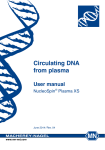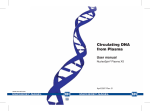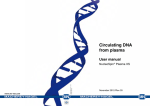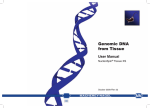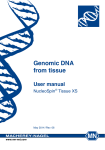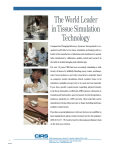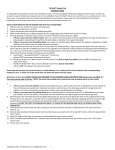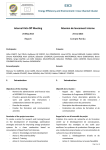Download Circulating DNA from Plasma
Transcript
Circulating DNA from Plasma User Manual NucleoSpin® Plasma XS February 2010 / Rev. 02 MACHEREY-NAGEL Circulating DNA from Plasma Protocol-at-a-glance (Rev. 02) NucleoSpin® Plasma XS 1 1a High Sensitivity protocol Rapid protocol Use up to 240 µl plasma Use up to 200 µl plasma Prepare sample Optional: Proteinase K treatment Add 20 µl Proteinase K / Mix Incubate at 37 °C for 10 min 2 3 4 Adjust binding conditions Mix sample Bind DNA Add 360 µl BB Add 300 µl BB Invert tube 3 x Invert tube 3 x Vortex 3 s Vortex 3 s Spin down briefly Spin down briefly Load lysate Load lysate 30 s 2,000 x g 30 s 11,000 x g 5s 11,000 x g 5 Wash and dry silica membrane 1st wash 500 µl WB 1st wash 500 µl WB 30 s 11,000 x g 2nd wash 250 µl WB 30 s 11,000 x g 2nd wash 250 µl WB 3 min 11,000 x g 6 7 Elute DNA Removal of residual ethanol 3 min 11,000 x g 20 µl Elution Buffer 20 µl Elution Buffer 30 s 11,000 x g 30 s 11,000 x g 8 min 90 °C / MACHEREY-NAGEL GmbH & Co. KG • Neumann-Neander-Str. 6-8 • D-52355 Düren • Germany Tel.: +49 (0) 24 21 969 270 • www.mn-net.com • e-mail: [email protected] MN Circulating DNA from Plasma Table of contents 1 2 Components 4 1.1 Kit contents 4 1.2 Consumables and equipment to be supplied by user 5 1.3 About this User Manual 5 Product description 6 2.1 The basic principle 6 2.2 Kit specifications 6 2.3 Handling of sample material 8 2.4 Elution procedures 8 2.5 Removal of residual traces of ethanol for highest PCR sensitivity 9 2.6 Stability of isolated DNA 10 3 Storage conditions and preparation of working solutions 11 4 Safety instructions – risk and safety phrases 12 5 Protocols 13 5.1 High Sensitivity protocol for the isolation of DNA from plasma 13 5.2 Rapid protocol for the isolation of DNA from plasma 16 Appendix 18 6.1 Troubleshooting 18 6 6.2 Ordering information 19 6.3 References 19 6.4 Product use restriction / warranty 22 MACHEREY-NAGEL – 02 / 2010, Rev. 02 3 Circulating DNA from Plasma 1 Components 1.1 Kit contents NucleoSpin® Plasma XS 10 preps 50 preps 250 preps 740900.10 740900.50 740900.250 Binding Buffer BB 4.5 ml 22 ml 110 ml Wash Buffer WB 10 ml 2 x 25 ml 250 ml Elution Buffer* 5 ml 5 ml 13 ml Proteinase K (lyophilized)** 6 mg 30 mg 2 x 75 mg Proteinase Buffer PB 0.8 ml 1.8 ml 8 ml NucleoSpin® Plasma XS Columns (red rings plus Collection Tubes) 10 50 250 Collection Tubes (2 ml) 20 100 500 User Manual 1 1 1 Cat. No. * Composition of Elution Buffer: 5 mM Tris/HCl, pH 8.5 ** For preparation of working solutions and storage condistions see section 3. 4 MACHEREY-NAGEL – 02 / 2010, Rev. 02 Circulating DNA from Plasma 1.2 Consumables and equipment to be supplied by user Consumables • 1.5 ml microcentrifuge tubes • Disposable pipette tips Equipment • Manual pipettors • Centrifuge for microcentrifuge tubes • Vortex mixer • Heating-block for incubation at 90 °C • Personal protection equipment (lab coat, gloves, goggles) 1.3 About this User Manual The manual provides two procedures differing in the number of handling steps, speed and performance. The High Sensitivity procedure is recommended if highest DNA yield and concentration is required. The Rapid procedure is recommended if shortest preparation time is required. It is strongly recommended reading the detailed protocol sections of this User Manual if the NucleoSpin® Plasma XS kit is used for the first time. Experienced users, however, may refer to the Protocol-at-a-glance instead. The Protocol-at-a-glance is designed to be used only as a supplemental tool for quick referencing while performing the purification procedure. All technical literature is available on the internet at www.mn-net.com. MACHEREY-NAGEL – 02 / 2010, Rev. 02 5 Circulating DNA from Plasma 2 Product description 2.1 The basic principle The NucleoSpin® Plasma XS kit is designed for the efficient isolation of circulating DNA from human blood plasma. Fragmented DNA as small as 50 – 1000 bp can be purified with high efficiency. Due to a special funnel design the NucleoSpin® Plasma XS Columns allow very small elution volumes (5 – 30 µl) which results in highly concentrated DNA. The protocol follows state-of-the-art bind-wash-elute procedures: After mixing of a plasma sample with the binding buffer, the mixture is applied to the NucleoSpin® Plasma XS Column. Upon loading of the mixture DNA binds to a silica membrane. Two subsequent washing steps efficiently remove contaminations and highly pure DNA is finally eluted with 5 – 30 µl of a slightly alkaline elution buffer of low ionic strength (5 mM Tris-HCl, pH 8.5). 2.2 Kit specifications 6 • The NucleoSpin® Plasma XS kit is recommended for the isolation of fragmented cell-free DNA from human EDTA plasma, serum, and bronchial lavage. • The NucleoSpin® Plasma XS kit is designed for high recovery, especially of fragmented DNA in a range of 50 – 1000 bp. • Up to 240 µl plasma can be used as sample material with a single column loading step. DNA yield strongly depends on the individual sample, but is typically in the range of 0.1 to 100 ng DNA per ml plasma. Up to 600 µl plasma can be used with three column loadings. • Elution can be performed with as little as 5 – 30 µl elution buffer. DNA is ready to use for downstream applications like real-time PCR or others. • The preparation time is approximately 15 – 30 min for 6 – 12 plasma samples. MACHEREY-NAGEL – 02 / 2010, Rev. 02 Circulating DNA from Plasma Table 1: Kit specifications at a glance Parameter NucleoSpin® Plasma XS Sample material Up to 200 µl EDTA plasma Average yield Typically in a range of 0.1 – 100 ng per ml plasma, depending on sample (depending on kind of patient samples, yield can be much higher). Elution volume 5 – 30 µl Preparation time High sensitivity procedure: 22 – 27 min / 6 preps Rapid procedure: 15 – 20 min / 6 preps Format XS spin column DNA yield from human plasma DNA amounts from less than 0.1 ng DNA per ml of plasma up to several 100 ng DNA per ml of plasma have been reported (Chiu et al. 2006; Chun et al. 2006; Fatouros et al. 2006; Lazar et al. 2006; Rainer et al. 2006; Rhodes et al. 2006; Schmidt et al. 2005). The content of DNA in plasma depends on: condition of the donor, sampling and handling of the blood, plasma preparation and DNA isolation method, DNA quantification method, and others. Size of circulating DNA A good portion of the cell-free DNA in plasma is resulting from apoptotic cells. As a result, a considerable percentage of this circulating nucleosomal DNA is known to be highly fragmented. However, the degree of fragmentation and the ratio of fragmented DNA to high molecular weight DNA depends on several parameters like origin of the DNA (e.g., fetal, tumor, microbial DNA), health of the blood donor, blood sampling procedure, and handling of the sample. The performance of many downstream applications depends on the efficient isolation even of smallest DNA fragments (Chan et al. 2006, 2005, 2004, 2003; Deligezer et al. 2006; Giacona et al. 1998; Hanley et al. 2006; Hromadnikova et al. 2006; Jiang et al. 2006; Koide et al. 2005; Li et al. 2006, 2005, 2004; Wang et al. 2004). According to this the NucleoSpin® Plasma XS purification system is designed for the efficient isolation of highly fragmented DNA in a range of 50 – 1000 bp. Within this range fragments are recovered with similar high efficiency. MACHEREY-NAGEL – 02 / 2010, Rev. 02 7 Circulating DNA from Plasma 2.3 Handling of sample material Several publications indicate strong influence of blood sampling, handling, storage, and plasma preparation on DNA yield and DNA quality (Page et al. 2006; Sozzi et al. 2005; Chan et al. 2005; Lam et al. 2004; Jung et al. 2003). Therefore it is highly recommended keeping blood sampling procedure, handling, storage, and plasma preparation method constant in order to achieve highest reproducibility. Plasma can be isolated according to protocols described in literature (e.g., Chiu and Lo 2006; Birch et al. 2005) or according to the following recommendation: Preparation of plasma from human EDTA blood 1 Centrifuge fresh blood sample for 10 min at 2,000 x g. 2 Remove the plasma without disturbing sedimented cells. 3 Freeze plasma at - 20 °C for storage upon DNA isolation. 4 Thaw frozen plasma samples prior to DNA isolation and centrifuge for 3 min at ≥ 11,000 x g in order to remove residual cells, cell debris, and particulate matter. Use the supernatant for DNA isolation. 2.4 Elution procedures The recommended standard elution volume is 20 µl. A reduction of the elution volume to 5 – 15 µl will increase DNA concentration, the total DNA yield is decreased by this reduction however. An increase of the elution volume to 30 µl or more will only slightly increase total DNA yield, but reduce DNA concentration. Figure 1 gives a graphic description of the correlation between elution volume and DNA concentration to help finding the optimized elution volume for your individual application. Figure 1: Correlation between elution volume and DNA concentration (NucleoSpin® Plasma XS Columns) 8 MACHEREY-NAGEL – 09 / 2008, Rev. 02 Circulating DNA from Plasma 2.5 Removal of residual traces of ethanol for highest PCR sensitivity A reduction of the 20 µl standard elution volume will increase the concentration of residual ethanol in the eluate. For 20 µl elution volume a heat incubation of the elution fraction (incubate eluate with open lid for 8 min at 90 °C) is recommended if the eluate comprises more than 20 % of the final PCR volume, in order to avoid an inhibition of sensitive downstream reactions. In this context, please mind the remarks below: • An incubation of the elution fraction at higher temperatures will increase signal output in PCR. This is of importance especially if the template represents more than 20 % of the total PCR reaction volume (e.g., more than 4 µl eluate used as template in a PCR reaction with a total volume of 20 µl). The template may represent up to 40 %* of the total PCR reaction volume, if the eluate is incubated at increased temperature as described. • A volume of 20 µl used for elution will evaporate to 12 – 14 µl during a heat incubation for 8 min at 90 °C. If a higher final volume is required, please increase the initial volume of elution buffer, for example from 20 µl to 30 µl. • An incubation of the elution fraction for 8 min at 90 °C will denature DNA. If non denatured DNA is required (e.g., for downstream applications other than PCR; like ligation or cloning), we recommend an incubation for longer time at a temperature below 80 °C as most of the DNA has a melting point above 80 °C. Suggestion: Incubate for 17 min at 75 °C. • The incubation of the eluate at higher temperatures may be adjusted according to Figure 2. The incubation times and conditions shown will reduce an initial elution volume of 20 µl to about 12 – 14 µl and will effectively remove traces of ethanol as described above. • If the initial volume of elution buffer applied to the column is less than 20 µl, time of heat incubation should be reduced to avoid complete dryness. * The maximum percentage of template volume in a PCR reaction may vary depending on the robustness of the PCR system; 40 % template volume were tested using LightCyclerTM PCR (Roche) with DyNAmoTM Capillary SYBR® Green qPCR Kit (Finnzymes). MACHEREY-NAGEL – 09 / 2008, Rev. 02 9 Circulating DNA from Plasma 25 without shaking 700 rpm 1400 rpm Incubation time [min] 20 15 10 5 0 65 70 75 80 85 90 95 Incubation temperature [°C] Figure 2: Removal of residual ethanol from the elution fraction by heat treatment. In order to obtain highest PCR sensitivity, heat incubation of the eluate is recommended. Heat incubation may be performed at temperatures of 70 – 90 °C in a heat block with or without shaking. Effective conditions (temperature, time, and shaking rate) for ethanol removal can be read from the diagram; an initial volume of 20 µl will evaporate to 12 – 14 µl during the described incubation. 2.6 Stability of isolated DNA Due to the typically low DNA content in plasma and the resulting low total amount of isolated DNA, its fragmentation, and the absence of DNase inhibitors (the elution buffer does NOT contain EDTA) the eluates should be placed on ice for short term and frozen at - 20 °C for long term storage. 10 MACHEREY-NAGEL – 02 / 2010, Rev. 02 Circulating DNA from Plasma 3 Storage conditions and preparation of working solutions Attention: The Buffer BB contains guanidine thiocyanate and ethanol! Wear gloves and goggles! Storage conditions: • All kit components can be stored at room temperature (18 – 25 °C) and are stable up to one year. • If there is any precipitate present in the buffers, warm the buffer up to 25 – 37 °C to dissolve the precipitate before use. Before starting any NucleoSpin® Plasma XS protocol prepare the following: • Before first use of the kit, add the indicated volume of Proteinase Buffer PB to dissolve lyophilized Proteinase K (see bottle or table below). Proteinase K solution is stable at -20 °C for 6 months. NucleoSpin® Plasma XS Cat. No. Proteinase K (lyophilized) 10 preps 50 preps 250 preps 740900.10 740900.50 740900.250 6 mg 30 mg 2 x 75 mg Add 260 µl Proteinase Buffer Add 1.35 µl Proteinase Buffer Add 3.35 ml Proteinase Buffer to each vial MACHEREY-NAGEL – 02 / 2010, Rev. 02 11 Genomic DNA from Plasma 4 Safety instructions – risk and safety phrases The following components of the NucleoSpin® Plasma XS kits contain hazardous contents. Wear gloves and goggles and follow the safety instructions given in this section. Component Hazard contents Hazard symbol Risk phrases Safety phrases BB Guanidine hydrochloride + ethanol < 45 % Xn* Flammable - Harmful by inhalation, in contact with the skin, and if swallowed R 1020/21/22 S 7-13-16 WB Ethanol < 60 % F* Highly flammable R 11 S 7-16 Proteinase K Proteinase K, lyophilized Xn Xi* Irritating to eyes, respiratory system and skin - May cause sensitization by inhalation R 36/37/3842 S 22-2426-36/37 Risk phrases R 10 Flammable R 11 Highly flammable R 20/21/22 Harmful by inhalation, in contact with the skin, and if swallowed R 36/37/38 Irritating to eyes, respiratory system, and skin R 42 May cause sensitization by inhalation Safety phrases S7 Keep container tightly closed S 13 Keep away from food, drink, and animal feedstuffs S 16 Keep away from sources of ignition - No Smoking! S 22 Do not breathe dust S 24 Avoid contact with the skin S 26 In case of contact with eyes, rinse immediately with plenty of water, and seek medical advice S 36/37 Wear suitable protective clothing and gloves * Hazard labeling not neccessary if quantity per bottle below 125 g or ml (certificate of exemption according to 67/548/EEC Art. 25, 1999/45/EC Art. 12 and German GefStoffV § 20 (3) and TRGS 200 7.1). For further information see Material Safety Data Sheet. 12 MACHEREY-NAGEL – 02 / 2010, Rev. 02 NucleoSpin® Plasma XS 5 Protocols Before starting the preparation: • Equilibrate sample to room temperature (18 – 25 °C) and make sure that the sample is cleared from residual cells, cell debris, and particular matter (e.g., by centrifugation of the plasma sample for 3 min at ≥ 11,000 x g). • For the High Sensitivity procedure: Set the thermal heating block to 75 °C – 90 °C for final ethanol removal (see section 2.6 for details). 5.1 High Sensitivity protocol for the isolation of DNA from plasma 1 Prepare sample Add 240 µl plasma to a microcentrifuge tube (not provided). 240 µl plasma Less than 240 µl may be used. Adopt the binding buffer volume accordingly (see below). 1a Optional: Proteinase K treatment Add 20 µl Proteinase K to the plasma sample, mix, and incubate at 37 °C for 10 min. Depending on the plasma sample and the PCR conditions, the proteinase treatment of the plasma sample provokes a increase of the PCR signal of 0.5 – 1.5 cycles, i.e. the cycle threshold (Ct-value) / crossing point (Cp-value) is reached 0.5 – 1.5 cycles earlier. The proteinase treatment may however alter the ratio of high to low molecular weight DNA. 2 Optional: + 20 µl Proteinase K Adjust DNA binding conditions Add 360 µl Buffer BB. + 360 µl BB If less than 240 µl plasma is used, adjust the binding buffer volume accordingly. A ratio of 1:1.5 (v / v) for plasma and binding buffer has to be ensured. 3 Mix sample Invert the tube 3 x and vortex for 3 s. Centrifuge the tube briefly to clean the lid. MACHEREY-NAGEL – 02 / 2010, Rev. 02 Mix sample 13 NucleoSpin® Plasma XS 4 Bind DNA For each sample, load the mixture (600 µl) to a NucleoSpin® Plasma XS Column placed in a Collection Tube (2 ml). Centrifuge at 2,000 x g for 30 s, increase centrifuge force to 11,000 x g for further 5 s. Discard Collection Tube with flow-through and place column into new Collection Tube (provided). The maximal column volume is approximately 600 µl. Do not apply a higher volume in order to avoid spillage. If larger plasma sample volumes have to be processed, the loading step may be repeated. Be aware of an increased risk of membrane clogging in case of multiple column loading steps. If the solution has not completely passed the column, centrifuge for an additional 60 s at 11,000 x g. 5 5s 11,000 x g + 500 µl WB Pipette 500 µl Buffer WB onto the NucleoSpin® Plasma XS Column. Centrifuge for 30 s at 11,000 x g. Discard Collection Tube with flow-through and place the column into new Collection Tube (provided). 2nd wash 30 s 11,000 x g + 250 µl WB Add 250 µl Buffer WB to the NucleoSpin Plasma XS Column. Centrifuge for 3 min at 11,000 x g. Discard Collection Tube with flow-through and place the column into a 1.5 ml microcentrifuge tube for elution (not provided). ® 3 min 11,000 x g Elute DNA Add 20 µl Elution Buffer to the NucleoSpin® Plasma XS Column. Centrifuge for 30 s at 11,000 x g. Elution volume may be varied in range of 5 – 30 µl. For a correlation of elution volume, DNA concentration, and DNA amount eluted from the column see section 2.4. 14 30 s 2,000 x g Wash and dry silica membrane 1st wash 6 Load lysate MACHEREY-NAGEL – 02 / 2010, Rev. 02 + 20 µl Elution Buffer 30 s 11,000 x g NucleoSpin® Plasma XS 7 Removal of residual ethanol Incubate elution fraction with open lid for 8 min at 90 °C. See section 2.5 for further comments and alternative incubation times and temperatures for a removal of residual ethanol. MACHEREY-NAGEL – 02 / 2010, Rev. 02 8 min 90 °C 15 NucleoSpin® Plasma XS 5.2 Rapid protocol for the isolation of DNA from plasma The rapid procedure represents a good compromise between DNA yield and concentration as well as ease and speed of nucleic acid extraction. 1 Prepare sample Add 200 µl plasma to a microcentrifuge tube (not provided). 200 µl plasma Less than 240 µl may be used. Adopt the binding buffer volume accordingly (see below). 2 Adjust DNA binding conditions Add 300 µl Buffer BB. + 300 µl BB If less than 200 µl plasma is used, adjust the binding buffer volume accordingly. A ratio of 1:1.5 (v / v) for plasma and binding buffer has to be ensured. 3 Mix sample Invert the tube 3 x and vortex for 3 s. Centrifuge the tube briefly to clean the lid. 4 Mix sample Bind DNA For each sample, load the mixture (500 µl) to a NucleoSpin® Plasma XS Column placed in a Collection Tube (2 ml). 16 Centrifuge at 11,000 x g for 30 s. Discard Collection Tube with flow-through and place column into new Collection Tube (provided). Load lysate The maximal column volume is approximately 600 µl. Do not apply a higher volume in order to avoid spillage. If larger plasma sample volumes have to be processed, the loading step may be repeated. Be aware of an increased risk of membrane clogging in case of multiple column loading steps. If the solution has not completely passed the column, centrifuge for an additional 60 s at 11,000 x g. 30 s 11,000 x g MACHEREY-NAGEL – 02 / 2010, Rev. 02 NucleoSpin® Plasma XS 5 Wash and dry silica membrane 1st wash + 500 µl WB Pipette 500 µl Buffer WB onto the NucleoSpin Plasma XS Column. Centrifuge for 30 s at 11,000 x g. Discard Collection Tube with flow-through and place the column into new Collection Tube (provided). ® 2nd wash + 250 µl WB Add 250 µl Buffer WB to the NucleoSpin® Plasma XS Column. Centrifuge for 3 min at 11,000 x g. Discard Collection Tube with flow-through and place the column into a 1.5 ml microcentrifuge tube for elution (not provided). 6 30 s 11,000 x g 3 min 11,000 x g Elute DNA Add 20 µl Elution Buffer to the NucleoSpin® Plasma XS Column. Centrifuge for 30 s at 11,000 x g. Elution volume may be varied in range of 5 – 30 µl. For a correlation of elution volume, DNA concentration, and DNA amount eluted from the column see section 2.4. MACHEREY-NAGEL – 02 / 2010, Rev. 02 + 20 µl Elution Buffer 30 s 11,000 x g 17 Circulating DNA from Plasma 6 Appendix 6.1 Troubleshooting Problem Possible cause and suggestions Low DNA content of the sample Low DNA yield • The content of cell-free DNA in human plasma may vary over several orders of magnitude. DNA contents from approximately 0.1 – 1000 ng DNA per ml of plasma have been reported (see remarks in section 2.2). Sample contains residual cell debris or cells Column clogging • No increase of PCR signal despite of an increased volume of eluate used as template in PCR Residual ethanol in eluate • The plasma sample may have contained residual cells or cell debris. Make sure to use only clear plasma samples (see remarks in section 2.3). Please see the detailed description of removal of residual traces of ethanol in section 2.5. Silica abrasion from the membrane • Discrepancy between A260 quantification values and PCR quantification values Due to the typically low DNA content in plasma and the resulting low total amount of isolated DNA, a DNA quantification via A260 absorption measurement is often hampered due to the low sensitivity of the absorption measurement. When performing absorption measurements close to the detection limit of the photometer, the measurement may be influenced by minor amounts of silica abrasion. In order to prevent incorrect A260-quantification of small DNA amounts, centrifuge the eluate for 30 s at > 11.000 x g and take an aliquot for measurement without disturbing any sediment. Alternatively, use a silica abrasion insensitive DNA quantification method (e.g., PicoGreen® fluorecent dye). Measurement not in the range of photometer detection limit Unexpected A260 /A280 ratio 18 • In order to obtain a significant A260 /A280 ratio, it is necessary that the initially measured A260 and A280 values are significantly above the detection limit of the photometer used. An A280 value close to the background noise of the photometer will cause unexpeced A260 /A280 ratios. MACHEREY-NAGEL – 02 / 2010, Rev. 02 Circulating DNA from Plasma 6.2 Ordering information Product Cat. No. Pack of NucleoSpin® Plasma XS 740900.10 / .50 / .250 10 / 50 / 250 Collection Tubes (2 ml) 740600 1000 6.3 References Birch L, English CA, O‘Donoghue K, Barigye O, Fisk NM, Keer JT: Accurate and robust quantification of circulating fetal and total DNA in maternal plasma from 5 to 41 weeks of gestation. Clin Chem. 2005 Feb;51(2):312-20. Epub 2004 Dec 17. Chan KC, Lo YM: Clinical applications of plasma Epstein-Barr virus DNA analysis and protocols for the quantitative analysis of the size of circulating Epstein-Barr virus DNA. Methods Mol Biol. 2006;336:111-21. Chan KC, Yeung SW, Lui WB, Rainer TH, Lo YM: Effects of preanalytical factors on the molecular size of cell-free DNA in blood. Clin Chem. 2005 Apr;51(4):781-4. Epub 2005 Feb 11. Chan KC, Zhang J, Chan AT, Lei KI, Leung SF, Chan LY, Chow KC, Lo YM: Molecular characterization of circulating EBV DNA in the plasma of nasopharyngeal carcinoma and lymphoma patients. Cancer Res. 2003 May 1;63(9):2028-32. Chan KC, Zhang J, Hui AB, Wong N, Lau TK, Leung TN, Lo KW, Huang DW, Lo YM: Size distributions of maternal and fetal DNA in maternal plasma. Clin Chem. 2004 Jan;50(1):88-92. Chiu RW, Lo YM: Noninvasive prenatal diagnosis by analysis of fetal DNA in maternal plasma. Methods Mol Biol. 2006;336:101-9. Chiu TW, Young R, Chan LY, Burd A, Lo DY: Plasma cell-free DNA as an indicator of severity of injury in burn patients. Clin Chem Lab Med. 2006;44(1):13-7. Chun FK, Muller I, Lange I, Friedrich MG, Erbersdobler A, Karakiewicz PI, Graefen M, Pantel K, Huland H, Schwarzenbach H: Circulating tumour-associated plasma DNA represents an independent and informative predictor of prostate cancer. BJU Int. 2006 Sep;98(3):544-8. Deligezer U, Erten N, Akisik EE, Dalay N: Circulating fragmented nucleosomal DNA and caspase-3 mRNA in patients with lymphoma and myeloma. Exp Mol Pathol. 2006 Feb;80(1):72-6. Epub 2005 Jun 15. Fatouros IG, Destouni A, Margonis K, Jamurtas AZ, Vrettou C, Kouretas D, Mastorakos G, Mitrakou A, Taxildaris K, Kanavakis E, Papassotiriou I: Cell-free plasma DNA as MACHEREY-NAGEL – 02 / 2010, Rev. 02 19 Circulating DNA from Plasma a novel marker of aseptic inflammation severity related to exercise overtraining. Clin Chem. 2006 Sep;52(9):1820-4. Epub 2006 Jul 13. Giacona MB, Ruben GC, Iczkowski KA, Roos TB, Porter DM, Sorenson GD: Cell-free DNA in human blood plasma: length measurements in patients with pancreatic cancer and healthy controls. Pancreas. 1998 Jul;17(1):89-97. Hanley R, Rieger-Christ KM, Canes D, Emara NR, Shuber AP, Boynton KA, Libertino JA, Summerhayes IC: DNA integrity assay: a plasma-based screening tool for the detection of prostate cancer. Clin Cancer Res. 2006 Aug 1;12(15):4569-74. Hromadnikova I, Zejskova L, Doucha J, Codl D: Quantification of fetal and total circulatory DNA in maternal plasma samples before and after size fractionation by agarose gel electrophoresis. DNA Cell Biol. 2006 Nov;25(11):635-40. Jiang WW, Zahurak M, Goldenberg D, Milman Y, Park HL, Westra WH, Koch W, Sidransky D, Califano J: Increased plasma DNA integrity index in head and neck cancer patients. Int J Cancer. 2006 Dec 1;119(11):2673-6. Jung M, Klotzek S, Lewandowski M, Fleischhacker M, Jung K: Changes in concentration of DNA in serum and plasma during storage of blood samples. Clin Chem. 2003 Jun;49(6 Pt 1):1028-9. Koide K, Sekizawa A, Iwasaki M, Matsuoka R, Honma S, Farina A, Saito H, Okai T: Fragmentation of cell-free fetal DNA in plasma and urine of pregnant women. Prenat Diagn. 2005 Jul;25(7):604-7. Lam NY, Rainer TH, Chiu RW, Lo YM: EDTA is a better anticoagulant than heparin or citrate for delayed blood processing for plasma DNA analysis. Clin Chem. 2004 Jan;50(1):256-7. Lazar L, Nagy B, Ban Z, Nagy GR, Papp Z: Presence of cell-free fetal DNA in plasma of women with ectopic pregnancies. Clin Chem. 2006 Aug;52(8):1599-601. Epub 2006 Jun 1. Li Y, Di Naro E, Vitucci A, Zimmermann B, Holzgreve W, Hahn S: Detection of paternally inherited fetal point mutations for beta-thalassemia using size-fractionated cell-free DNA in maternal plasma. JAMA. 2005 Feb 16;293(7):843-9. Erratum in: JAMA. 2005 Apr 13;293(14):1728. Li Y, Holzgreve W, DI Naro E, Vitucci A, Hahn S: Cell-free DNA in maternal plasma: is it all a question of size? Ann N Y Acad Sci. 2006 Sep;1075:81-7. Li Y, Holzgreve W, Page-Christiaens GC, Gille JJ, Hahn S: Improved prenatal detection of a fetal point mutation for achondroplasia by the use of size-fractionated circulatory DNA in maternal plasma--case report. Prenat Diagn. 2004 Nov;24(11):896-8. Li Y, Wenzel F, Holzgreve W, Hahn S: Genotyping fetal paternally inherited SNPs by MALDI-TOF MS using cell-free fetal DNA in maternal plasma: influence of size fractionation. Electrophoresis. 2006 Oct;27(19):3889-96. 20 MACHEREY-NAGEL – 02 / 2010, Rev. 02 Circulating DNA from Plasma Li Y, Zimmermann B, Rusterholz C, Kang A, Holzgreve W, Hahn S: Size separation of circulatory DNA in maternal plasma permits ready detection of fetal DNA polymorphisms. Clin Chem. 2004 Jun;50(6):1002-11. Epub 2004 Apr 8. Page K, Powles T, Slade MJ, DE Bella MT, Walker RA, Coombes RC, Shaw JA: The Importance of Careful Blood Processing in Isolation of Cell-Free DNA. Ann N Y Acad Sci. 2006 Sep; 1075:313-317. Rainer TH, Lam NY, Man CY, Chiu RW, Woo KS, Lo YM: Plasma beta-globin DNA as a prognostic marker in chest pain patients. Clin Chim Acta. 2006 Jun;368(1-2):110-3. Epub 2006 Feb 14. Rhodes A, Wort SJ, Thomas H, Collinson P, Bennett ED: Plasma DNA concentration as a predictor of mortality and sepsis in critically ill patients. Crit Care. 2006;10(2): R60. Schmidt B, Weickmann S, Witt C, Fleischhacker M: Improved method for isolating cellfree DNA. Clin Chem. 2005 Aug;51(8):1561-3. Sozzi G, Roz L, Conte D, Mariani L, Andriani F, Verderio P, Pastorino U: Effects of prolonged storage of whole plasma or isolated plasma DNA on the results of circulating DNA quantification assays. J Natl Cancer Inst. 2005 Dec 21;97(24):1848-50. Wang M, Block TM, Steel L, Brenner DE, Su YH: Preferential isolation of fragmented DNA enhances the detection of circulating mutated k-ras DNA. Clin Chem. 2004 Jan;50(1):211-3. MACHEREY-NAGEL – 02 / 2010, Rev. 02 21 Circulating DNA from Plasma 6.4 Product use restriction / warranty NucleoSpin® Plasma XS kit components were developed, designed, distributed, and sold FOR RESEARCH PURPOSES ONLY. They are suitable FOR IN - VITRO USES ONLY. No claim or representation is intended for its use to identify any specific organism or for clinical use (diagnostic, prognostic, therapeutic, or blood banking). It is rather the responsibility of the user to verify the use of the NucleoSpin® Plasma XS kit for a specific application range as the performance characteristic of this kit has not been verified to a specific organism. This MACHEREY-NAGEL product is shipped with documentation stating specifications and other technical information. MACHEREY-NAGEL warrants to meet the stated specifications. MACHEREY-NAGEL´s sole obligation and the customer´s sole remedy is limited to replacement of products free of charge in the event products fail to perform as warranted. Supplementary reference is made to the general business terms and conditions of MACHEREY-NAGEL, which are printed on the price list. Please contact us if you wish an extra copy. MACHEREY-NAGEL does not warrant against damages or defects arising in shipping and handling (transport insurance for customers excluded), or out of accident or improper or abnormal use of this product; against defects in products or components not manufactured by MACHEREY-NAGEL, or against damages resulting from such non-MACHEREY-NAGEL components or products. MACHEREY-NAGEL makes no other warranty of any kind whatsoever, and SPECIFICALLY DISCLAIMS AND EXCLUDES ALL OTHER WARRANTIES OF ANY KIND OR NATURE WHATSOEVER, DIRECTLY OR INDIRECTLY, EXPRESS OR IMPLIED, INCLUDING, WITHOUT LIMITATION, AS TO THE SUITABILITY, REPRODUCTIVITY, DURABILITY, FITNESS FOR A PARTICULAR PURPOSE OR USE, MERCHANTABILITY, CONDITION, OR ANY OTHER MATTER WITH RESPECT TO MACHEREY-NAGEL PRODUCTS. In no event shall MACHEREY-NAGEL be liable for claims for any other damages, whether direct, indirect, incidental, compensatory, foreseeable, consequential, or special (including but not limited to loss of use, revenue or profit), whether based upon warranty, contract, tort (including negligence) or strict liability arising in connection with the sale or the failure of MACHEREY-NAGEL products to perform in accordance with the stated specifications. This warranty is exclusive and MACHEREY-NAGEL makes no other warranty expressed or implied. The warranty provided herein and the data, specifications and descriptions of this MACHEREY-NAGEL product appearing in MACHEREY-NAGEL published catalogues and product literature are MACHEREY-NAGEL´s sole representations concerning the product and warranty. No other statements or representations, written or oral, by MACHEREY-NAGEL´s employees, agent or representatives, except written statements signed by a duly authorized officer of MACHEREY-NAGEL are authorized; they should not be relied upon by the customer and are not a part of the contract of sale or of this warranty. 22 MACHEREY-NAGEL – 02 / 2010, Rev. 02 Circulating DNA from Plasma Product claims are subject to change. Therefore please contact our Technical Service Team for the most up-to-date information on MACHEREY-NAGEL products. You may also contact your local distributor for general scientific information. Applications mentioned in MACHEREY-NAGEL literature are provided for informational purposes only. MACHEREY-NAGEL does not warrant that all applications have been tested in MACHEREY-NAGEL laboratories using MACHEREY-NAGEL products. MACHEREYNAGEL does not warrant the correctness of any of those applications. Please contact: MACHEREY-NAGEL Germany Tel.: +49 (0) 24 21 969 270 e-mail: [email protected] Last updated: 12 / 2006, Rev. 02 Trademarks: DyNAmo is a trademark of Finnzymes Oy LightCycler is a trademark of a member of the Roche Group NucleoSpin is a trademark of MACHEREY-NAGEL GmbH & Co KG PicoGreen is a registered trademark of Molecular Probes, Inc. SYBR is a registered trademark of Molecular Probes, Inc. All used names and denotations can be brands, trademarks, or registered labels of their respective owner – also if they are not special denotation. To mention products and brands is only a kind of information (i.e., it does not offend against trademarks and brands and can not be seen as a kind of recommendation or assessment). Regarding these products or services we can not grant any guarantees regarding selection, efficiency, or operation. MACHEREY-NAGEL – 02 / 2010, Rev. 02 23























